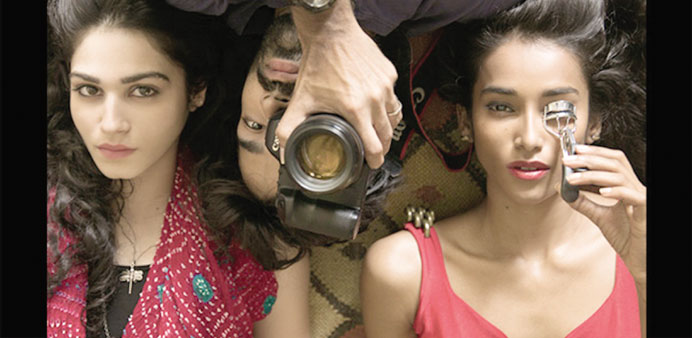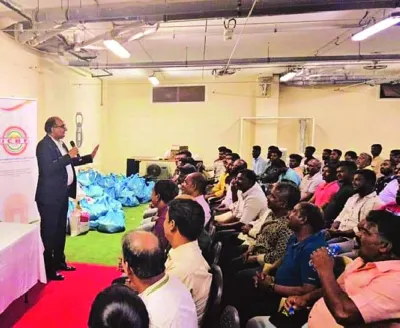SUPERFICIAL: A promotional image for Kaash.
By Gautaman Bhaskaran
As the 28th edition of the Tokyo International Film Festival winds to a close in the next couple of days and I fly back home in Chennai, I would have the sense of satisfaction of having seen all the three Indian movies at the 10-day cinematic event.
While Mani Ratnam’s O Kadhal Kanmani opened in India a while ago and I had also penned a column on it, I would confine myself to the other two Indian films here. These two titles, vastly varied in genre, approach and style, are yet to hit the theatres in India. (Will they at all?)
Umesh Aggarwal’s biopic of sorts on the Mozart of Madras, AR Rahman, has been shot in a pure documentary style, while Mira Nair’s nephew, Ishaan Nair, uses the fiction format in Kaash (If Only) to tell us the story of a young New York based photographer, Aadil (played by debutant Varun Mitra), who returns to Mumbai to be with the girl he loves, Samira (newcomer Nidhi Sunil), a dusky actress, fighting the prejudice of colour in a fair-is-lovely Bollywood. And not just colour, but also sexual predators.
Ishaan’s movie has been co-produced by Irrfan Khan, and one had expected that it would be something as novel as Lunchbox or Paan Singh Tomar or the latest Talvar — works that he has been associated with — but Kaash (If Only) has little beyond fascinating photography or some above average acting.
We have seen a million times friction between two lovers, and this is precisely what splits Aadil and Samira, her desperate effort to get a foothold (nay toehold) in Bollywood — where colour and sexual favours decide one’s opportunities — messing up her personal life. Samira obviously has no choice but to show her skin and meet the sexual demands of her producer, much to the chagrin of Aadil, and his relationship with her goes on a fatal spin.
Aadil moves from Mumbai to Ahmedabad — where he had made an internet friend, Khushali (also essayed by a new talent, Kavya Trehan) — but the young photographer cannot just let go the memory of Samira. In Khushali, he begins to search for and finds a lot of Samira. And despite Khushali’s sunny disposition and let-us-give-this-relationship-a-chance attitude, she just cannot tear Aadil away from his former lover. So, she tears herself away from him.
A cameo by Kalki Koechlin as a French hippie, Elsbeth, whom Aadil and Khushali meet as they wander around the Rann of Kutch in Gujarat, does not add up to anything, but, yes, mercifully she plays a French woman — which she is — her English and Hindi spoken with a Gallic accent sounding more authentic here then ever before. What a relief this is!
Aggarwal’s study of Rahman’s method and music in Jai Ho has a lot more to offer than Nair’s on-the-surface-kind-of narrative that leaves one pretty dissatisfied. There are some great musical moments in the documentary, which is, strictly speaking, not a biopic, but an attempt to analyse the evolution of Rahman’s music during the 20 (120 films) years he has been around — a career that fetched him a couple of Oscars, one for Danny Boyle’s Slumdog Millionaire, for the song Jai Ho. Also the inspiration for this documentary’s title, the song made Rahman a pop icon — somewhat on the lines of the Beetles in the 1960s.
If one were to describe the reason for Rahman’s phenomenal success in just a single sentence, it will be his ability to fuse Western technology with Eastern sensibilities.
Born a Hindu, he converted to Islam in 1989, when he was 23, and changed his name from Dileep Kumar to Allah Rakha Rahman, and Aggarwal’s work uses interesting inputs from Shekar Kapur, Gulzar and Boyle to detail Rahman’s musical journey. The only thing that Rahman cannot do is write lyrics, says Gulzar. Otherwise, he is a master of just about every aspect of the music he creates. He has learnt to use several instruments and even sings.
A complete Rahman fan, Aggarwal uses the 90 minutes in his documentary to present mostly the maestro’s life in music. When the film does get out of this mode it is to talk briefly about Rahman’s conversion, his father’s death, his mother’s dream to see him as a musician, his marriage and the conflict between his love for his wife and mother. As the mother says in one scene, “every family has its problems”.
Enriching enormously Aggarwal’s work is the lilting music from movies such as Mani Ratnam’s Roja and Bombay in particular, and if there is one grouse that I may harbour about the movie, it is the absence of longer music tracks — whose notes have been mesmerising hundreds of thousands of people across continents. And for a long, long time.
Finally, was Rahman happy with Aggarwal’s work? A story in The Hindu has this quotation from Rahman that raises a wee bit of doubt in us. “Look, I have some out-of-the-world shots and I wanted to make a movie with it. If I had shared those shots, the film would have gone several notches up. The best, however, was that they managed to surpass my personal life and interviewed so many international icons…” Rahman leaves the sentence half way.
Rahman does not talk much, instead letting his music do that. But the message in The Hindu interview appears all too telling.
Anyway, this is nothing new. Artists are difficult to please. Kerala writer Paul Zacharia was not happy with the way Adoor Gopalakrishnan had adapted and filmed Vidheyan. Based on Zacharia’s literary work, Vidheyan had Mammootty playing a bully — and I dare say it was one of Adoor’s classic titles.
Finally, I must add that Aggarwal’s documentary is quite a fascinating study of Rahman’s method and music, and, yes, the celluloid work may well seduce one to fall in love with the maestro’s melody.
*Gautaman Bhaskaran is covering the Tokyo International Film Festival, and may be emailed at [email protected]



